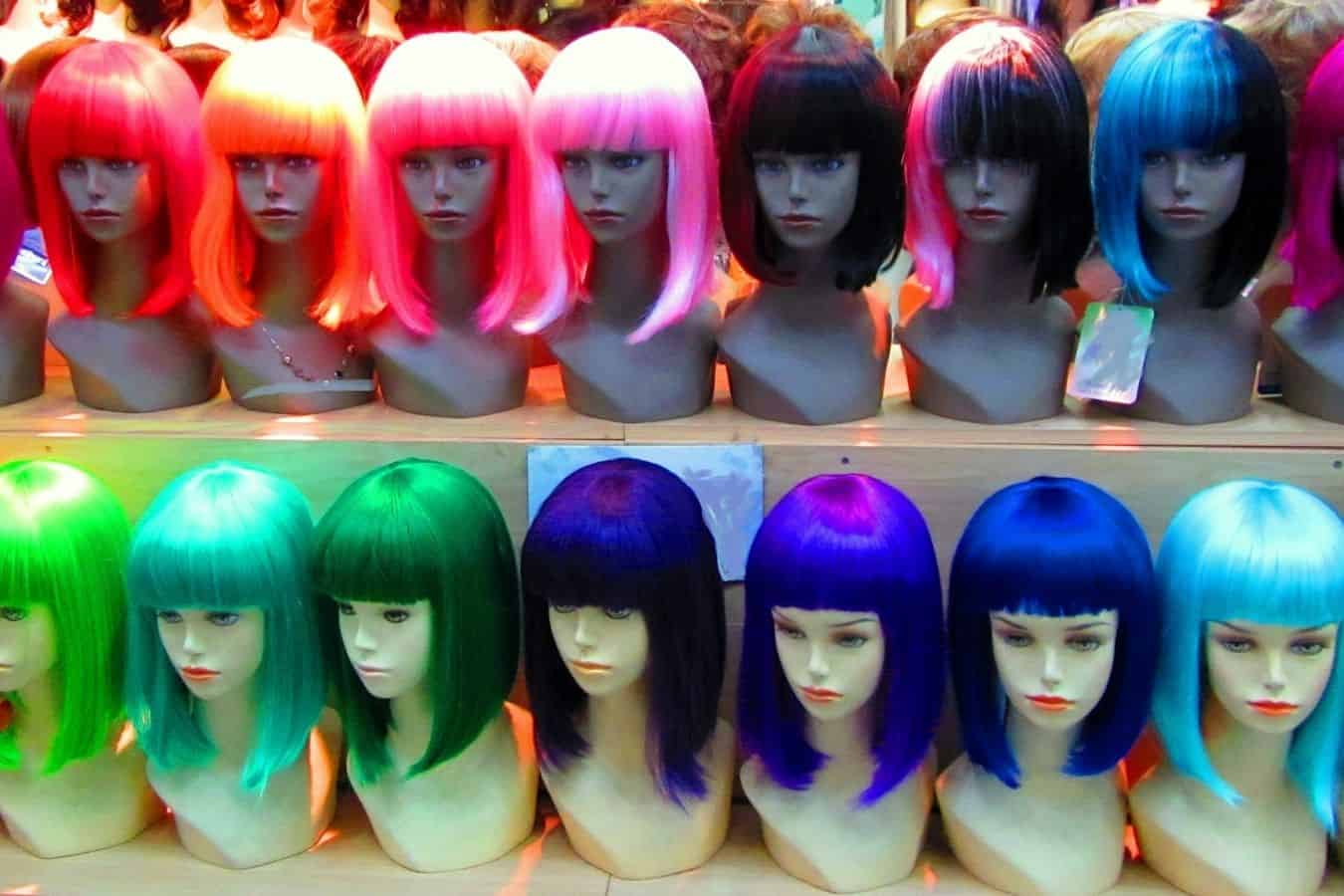If you’re looking for a revamp, or just want to shake things up a little then you may be thinking about dying your wig. In this article, we will cover how to dye synthetic hair and provide you with useful tips and advice!

Synthetic hair can be dyed using fabric dye and boiling water. You will need to ensure the synthetic hair is heat resistant. Be prepared to take the risk of the process not going exactly as planned as the processed fibers which make up your synthetic wig may not take the color as you intend.
What Is Synthetic Hair?
Synthetic hair is created using man-made fibers. Fine threads are manufactured which are made from polymers and designed to look and feel as close to human hair as possible.
The threads can then be used to make a wig, weave, or extensions. A key difference between human hair and synthetic hair is that synthetic hair contains no keratin.
The man-made polymers used in the production of synthetic hair are often coupled with plastics. Various plastics are used in this process.
Can You Dye Synthetic Hair?
It is not widely recommended that you dye synthetic hair. As a relatively affordable product that is available in a variety of colors, it is considered unnecessary.
However, if your extensions don’t match your hair color and you have set your sights on doing it, it can be done!
The processed fibers of synthetic hair make it difficult to dye – but not impossible.
Unlike human hair, synthetic hair does not have natural pigments which makes it impenetrable to hair dye.
Furthermore, hair dye can make synthetic hair frizzy and even destroy it as a result of the ingredients such as ammonia or bleach.
So, what can you use? Well, there are a few options: acrylic ink, Rit dye, sharpie ink, or fabric dye.
Which Wigs Are Suitable for Dyeing?

It is useful to note that synthetic hair cannot be bleached. the bleach will simply destroy the man-made fibers that make up your synthetic hair.
Let’s take a look at the different types of wigs:
Light Colored Synthetic Hair
Lighter color synthetic hair is more receptive to color. White hair, silver hair, and pastel-colored hair are all good colors to use.
To re-iterate, dark synthetic hair will not go lighter using bleach. It is much harder to change the color of dark synthetic hair.
However, if you had a dark brown wig, you could dye it black.
Basically, darker dyes work better in the process. You are more likely to be successful in changing the color of your synthetic hair if you aim for darker colors or richer shades.
Cheaper Synthetic Hair
It is better to use cheaper synthetic hair if you wish to change its color.
When undertaking this process, there is always a chance that the synthetic hair will get destroyed so better to use one you haven’t spent a lot of money on.
As well as this, more expensive and perhaps higher quality synthetic hair tends to be smoother in texture which makes it less accommodating to the dye colors.
They will wash off easily, thus making the whole process a bit of a wasted effort.
How to Dye Synthetic Hair

There are a few ways you can dye your synthetic hair.
Before you begin the process of dying, you may want to give the synthetic hair a wash to remove any dirt, sweat or styling products that have accumulated.
Use a mild shampoo for this. Let it dry before beginning the process.
1. Fabric Dye
You will need:
- Heat-resistant synthetic hair
- 1 bottle of fabric dye (for polyester and synthetic materials)
- Large pot
- Stove
- Water
- Newspapers/cover
- Disposable Gloves
- Old clothes/apron
Instructions
- Put on old clothes or cover your clothes with an apron to avoid ruining any clothes you still wish to wear. Cover your worksurface with newspaper or some sort of protective covering. Put on the disposable gloves.
- Add water to the large pot and bring to the boil- make sure your synthetic hair will fit into the pot. As a rule of thumb, for every cup of water you add, you’ll want to add 3 teaspoons of fabric dye.
- When the water has reached boiling point, add the dye and reduce the water to a simmer.
- Dampen the hair before you add it to the pot as this makes it a little easier to dye.
- Place the synthetic hair in the pot. The longer you leave it, the darker the result will be. This can take anywhere between a few seconds and a few minutes.
- When you remove the hair from the pot, rinse it under cold water until it runs clear.
- Place it or hang it somewhere to air-dry. If you are dying a wig, you could place it on a wig stand.
2. Acrylic Ink
You will need:
- Acrylic ink
- Spray bottle
- Comb
- Water
- Disposable gloves
- Newspapers/ covers
Instructions:
1.Pour the acrylic ink into the spray bottle and add some rubbing alcohol- the more rubbing alcohol you use, the lighter your color will come out. (Use approximately 3 tablespoons of rubbing alcohol to ¼ tablespoon of the acrylic ink).
2.Put on the gloves to keep your hands clean and cover your work surface with the newspaper to protect it.
3. Spray the dye mixture onto the synthetic hair. Use your hands to work it through and lift the sections to ensure you color the underside too.
4. Use a dye to comb it through and make sure the color is coating all the strands.
5. Place it or hang it to air-dry.
6. When it is dry rinse with cold water until the water runs clear.
7. Leave it to dry again.
3.Sharpie Ink
You will need:
- Sharpie pens
- Sharp knife
- Pliers
- Spray bottle
- Rubbing alcohol
- Disposable gloves
- Newspaper/ cover
Instructions:
- Cover your worksurface.
- Use the pliers to pull the sharpie pen apart- you are trying to free the ink tube inside.
- Now, use the pliers to remove the small tip from the front of the sharpie which should give you some extra ink.
- Using the sharp knife, carefully slice open the ink tube.
- Put the ink tube into the spray bottle and add some alcohol.
- Leave this to sit for as long as possible to get the most out of the ink. If you can leave this process to work overnight, even better.
- Spray the dye mixture onto the synthetic hair. Use your hands to work it through and lift the sections to ensure you color the underside too.
- Use a dye to comb it through and make sure the color is coating all the strands.
- Place it or hang it to air-dry.
- When it is dry rinse with cold water until the water runs clear.
- Leave it to dry again.
Quick Method
For methods 2 and 3, you can speed up the process a little by putting the dye mixture in a plastic bag and placing the synthetic hair in the bag to soak.
Start with a minimum of 5 minutes then increase this depending on how intense you want the color to come out. Remove it and leave it to dry completely before rinsing with cold water.
4. Rit Dye
You will need:
- Liquid Rit dye or powdered Rit dye
- Hot water
- Sponge
- Large bowl
- Disposable gloves
- Newspaper/cover
- Cup
Instructions:
1. Cover your work surface with newspaper and put on disposable gloves.
2. Pour 1 cup of liquid Rit dye into the large bowl. Alternatively, dissolve 1 teaspoon of powdered Rit dye into 1/2 cup of hot water (140 degrees Fahrenheit). You can use the stove and a pan to achieve this if your tap water does not reach this temperature.
3. Dip the sponge into the dye and squeeze out any excess.
4. Using the sponge, apply the dye to the synthetic hair in stroking motions, working from the scalp down the shaft.
5. Leave this to work for approximately 20 minutes.
6. Rinse the hair in cold running water until the water runs clear.
7. Leave the hair to air-dry naturally.
Be aware that natural fibers are more porous to rit dye, but they can work on synthetic hair. It depends on the fiber composition and how they were treated.
Aftercare of Dyed Synthetic Hair
Do not apply heat to dry the synthetic hair in any of the above methods as heat will damage the synthetic fibers.
How Long Will The Dye Last?
The dye should last until you wash it with warm or hot water. So, in theory, as you don’t need to wash synthetic hair very often this could be quite a while.
If you do decide to wash the color out, take care that it doesn’t become tangled.
If you decide to undertake this process, be aware that it does not always go as planned. But as long as you are prepared to take that risk, the results can be both exciting and rewarding!
Disclaimer: This site is not intended to provide professional or medical advice. All of the content on LovedByCurls.com is for informational purposes only. All advice should be followed at your own discretion. Ingredients may change at any time so always check the product label before using. Check our full disclaimer policy here.
